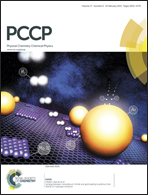The chain conformation and relaxation dynamics of poly(acrylic acid)-graft-poly(ethylene oxide)-graft-dodecyl in water: effect of side-chains and distribution of counterions
Abstract
We present a study on the dielectric behavior of an aqueous solution of an amphiphilic copolymer, poly(acrylic acid)-graft-poly(ethylene oxide)-graft-dodecyl (PAA-g-PEO-g-dodecyl), in the frequency range of 40 Hz to 110 MHz at varying concentrations and temperatures. After eliminating the electrode polarization at low-frequency, three dielectric relaxation processes were observed at about 1.2 MHz, 150 kHz and 30 kHz, whose mechanisms were proved to originate from the fluctuations of free counterions, the fluctuation of condensed counterions, and the rotation of intramolecular aggregates, respectively. The concentration dependence of the dielectric increment Δε and relaxation time τ for these three relaxations presents an abrupt change at 0.15 mg ml−1, indicating that PAA-g-PEO-g-dodecyl molecules undergo a conformational transition from intramolecular aggregates to intermolecular aggregates. Moreover, both Δε and τ show a clear transition at about 317 K, suggesting a partial collapse of the aggregates. The correlation length and the contour length of the PAA-g-PEO-g-dodecyl chain were estimated according to Ito's theory of counterion fluctuation. It was found that the hydrophobic/hydrophilic side-chains affected the microscopic conformation of PAA, and the hydrogen-bond interactions greatly influenced the conformation. Additionally, the activation energy of these three relaxations was calculated and the process of ionic conduction was studied and the results were used to discuss counterion distribution and ion conduction.


 Please wait while we load your content...
Please wait while we load your content...